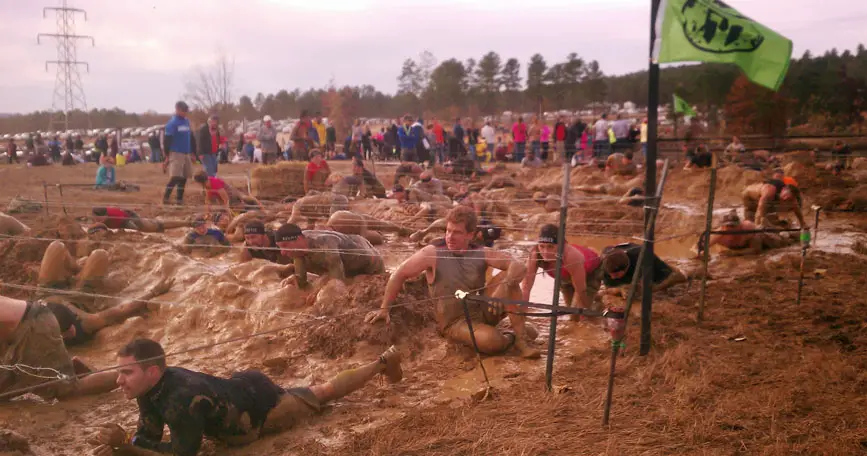
Joining mud runs is a great way to test every bit of capability that your body has to offer. From dealing with different obstacles to transitioning through unpredictable terrain, before you head out to face those challenges, take a moment to scan through the following safety tips that might help you get through your first ever mud race.
- Get familiar with the race course.
- Make preparations.
- Have a diet plan.
- Wear smart.
- Be comfortable with your race gear.
- Have enough rest.
- Have an adequate meal during race day.
- Warm up.
- Do a last minute body-check.
- Be patient.
- Be friendly.
- Watch and learn.
- Try to keep distance.
- Make use all of the body parts if possible.
- Don’t let your ego get to you.
Some of these 15 useful tips might be crystal clear to you while the others are still vague. Let us go through each tip one by one for more handy tidbits of information to make your first mud run race a memorable one . . . An unforgettable one not because of injuries, but because of the utmost fun from an adrenaline-pumping experience!
1. Get Familiar with the Race Course
Always make sure to know what you will be going up against. Awareness of the terrain and other challenges that you may face will enable you to be more prepared.
Even if you came to learn about the race course at a later time, you would be able to do some quick adjustments to your training regimen to match the obstacles that you are going to encounter. In the end, it is always better to do a few hours of research than having no information at all.
2. Make Preparations
Planning on how you attack every obstacle course is critical. A proper training program is also essential so you can effectively execute strategies and techniques to conquer the course.
Before you step on the starting line, you have to be physically and mentally prepared. Inadequate preparation can pose higher risk for injuries or accidents, especially if your mind thinks you can do it but your body is not really up for it.
3. Have a Diet Plan
It is important to fuel your body with proper nutrition and keep it sufficiently hydrated throughout the course. Having a high-carbohydrate, low-fiber and low-fat diet two to three days before a race will easily provide your muscles with enough stored energy to the final stages of your training. Having this type of diet will also help prevent any stomach discomfort that might upset your chance of joining the race.
After the event, immediately replace depleted nutrients by consuming carb-packed foods. Drink sports drinks to replenish the water lost from your body. Keep some snacks ready and available packed in your bag or in your car to continue your recovery process en route to the hotel or home.
4. Wear Smart
Choose an attire that will complement the type of obstacles you will be doing. Wearing light and less restrictive clothing is always good. Select ones with a fabric that can wick sweat away, keeping it light and dry. For those who wish to avoid abrasions and cuts, wearing tights and high socks is ideal.
It is also worth it to keep track on the weather forecast days before the race as you don’t want to be wearing any thick layered rash guard under the scorching sun nor being topless on a windy day.
5. Be Comfortable with Your Race Gear
By race day, you want to have tested out all of your gears and have identified the ideal and most comfortable set to use. For some people, the set they use during race day is also the one they used during training.
Avoid wearing new shoes and clothing as it will definitely cause blisters and abrasions in your skin as you go along with the race. In any case, always bring with you a bottle of vaseline to apply into the skin that is being irritated.
6. Have Enough Rest
Resting a day before the event to give your body an opportunity to recuperate and heal from the training that you have done so far. As you rest, any muscle damage will slowly fix itself preventing internal injuries to develop. Fatigue in your body will also slowly decrease making it easier for your brain and muscles to be in sync.
For beginners, it is advisable that you try to go to bed early before a race to provide a buffer on the time you will spend in calming yourself from the anxiety and excitement before you doze off.
7. Have an Adequate Meal During Race Day
It is recommended to eat three hours before the start of the mud run. If the event happens to start early, then just wake up a couple of hours past midnight, have your meal and go back to bed. Keep in mind to avoid eating heavy meals during this time.
Make sure to drink a lot of fluid 15 to 30 minutes before the event begins. The amount of fluid you drink will depend on how much you consume during your training. Remember, that unlike any normal racing events like marathons and cycling, there are usually no water stops within the obstacle course.
8. Warm Up
Like any other sports activities, warm up is a staple before you start doing anything strenuous. Ideally, prior to the start of the gun fire, there will be a few minutes to do some warming up, so use that opportunity to do some light jogging, jacks, or just walking at a light intensity to start your blood pumping, followed by some body stretching. Once you do that, you’ll worry less about getting any muscle cramps and sprains.
Be reminded that even if it’s just a simple warm up, doing it properly will go a long way in your performance during the race as this allows your muscles and tendons to be more flexible and energetic.
9. Do a Last Minute Body-check
Doing a self-check before going to the starting line is something that most people tend to overlook as they would assume that the feeling they are currently experiencing is just some pre-race jitters. When you’re not feeling well, try to calm down and loosen up.
Still, if you really are not feeling well, it is also wise to step back and just wait for the next opportunity to join another event.
10. Be Patient
A common mistake observed from beginners is dashing up ahead once the gun fire is heard. In a mud run, speed is only secondary, what is important is being patient in finishing the whole course. Know when to pace up and when to slow down in order to preserve as much energy as you can for the next obstacle.
Rushing will only push you to an early exhaustion and possible injury. Trying to speed up only to learn that behind the hill or the log that you just jumped over is a downhill slope or a pool of water that can catch you off guard.
11. Be Friendly
Being friendly to other participants from the start will not only make the event enjoyable but also, it makes a good strategy in finishing every obstacle course. Mud runs are not just designed for individuals, it can also become a team effort event. Interacting with other participants can make a difficult obstacle easier and safer as they provide good support and guidance.
Who knows, you might be earning new friends after the event.
12. Watch and Learn
One good thing about mud runs is that there are many ways of doing an obstacle course. It is not always that our techniques and strategies are the most effective.
Slowing down and watching other people do their techniques is sometimes the most efficient way and safest way to finish an obstacle. There is nothing bad in doing what the others are doing as long as you are able to complete the event safely.
13. Try to Keep Distance
If the obstacle course allows it, try to maintain a safe distance from other people. With your whole body moving, there is a chance of hitting other people and vice versa. Most people would not care much about bumping into each other, but it’s still better to avoid any bruise or two from appearing after the event is finished.
14. Make Use of All Body Parts if Possible
Joining mud runs means that you are expected to get dirty and wet, so rather than avoiding all the mud getting into your clothes (which will eventually happen sooner or later), embrace the experience. Utilize all your body parts, if the obstacle requires you to crawl, use both your hands, your feet and your stomach to push yourself forward. When going downhill, use both your hands to support your body, both your feet to control your pace and your buttocks to provide a good balance as you progress downwards.
15. Don’t Let Your Ego Get to You
It is important to just focus on finishing the race safely while finishing every obstacle course. Maintain your pace rather than trying to outdo every participant you encounter. Enjoy the race and have fun, do not be too competitive only to end up sustaining injuries just because you tried to outpace someone.
Bonus: Bring a Buddy
Lastly, having a racing buddy makes a lot of difference and can drastically lighten the load and pressure that you will be experiencing during every obstacle. Not only will there be someone to provide help on those obstacles, there will also be someone to watch your back for the whole duration of the event.
In Essence
Accidents and injuries are risks involved in mud runs. However, proper planning not just prevents poor performance in a race but more importantly, prevents potential harm.
